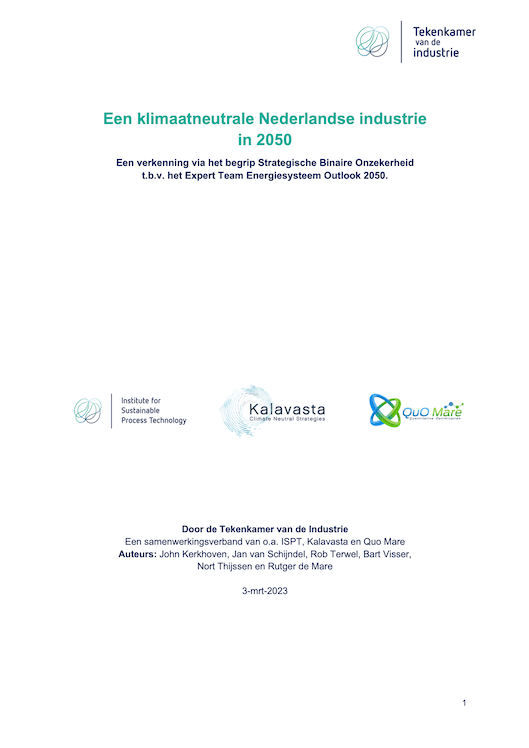TvdI ETES Outlook 2050
The Expert Team Energiesysteem Outlook 2050 requested the Drawing Room of the Industry, of which Kalavasta is a member, to give input on the industry part of the Outlook 2050.

Why was input requested by the Expert Team Energiesysteem Outlook 2050?
The Minister of Climate and Energy installed in April 2022 a team of independent experts to develop an outlook for Dutch society and the energy system in 2050. In December 2022 the Expert Team Energy System Outlook 2050 (ETES) struggled with the outlook for the Dutch Industry. This was partially because of the large impact the industry has on the energy system and because of the uncertainty of what the current industry is going to do, given that there are various paths to climate neutrality and what new industry could emerge. Hence, they asked input from the Drawing Room of the Industry.
Why was the Drawing Room of the Industry asked to give input?
The Drawing Room of the Industry (“Tekenkamer van de Industrie” or TvdI) is a cooperation of the Institute of Sustainable Process Technology, QuoMare and Kalavasta. The TvdI is funded by Dutch Industry and the Dutch Grid Operators. In the past 12 months the members of the TvdI had conducted various large scale scenario studies into the future of the Dutch Industry. Kalavasta, in particular, executed the II3050 industry scenario exercise in 2022, which involved more than 120 one-on-one conversations with representatives from the Dutch Industry. QuoMare had conducted several studies within Dutch Clusters in 2022.
What were the main questions of the Expert Team to the Drawing Room of the Industry?
Can you answer in approximately four weeks the following questions. What role does industry play in a climate-neutral Netherlands? Which sectors will remain, which may disappear, and will new types of industry appear? What is the influence of these changes on energy use and infrastructure?
How did you answer those questions, given the time constraint?
On the basis of logical reasoning and using the knowledge acquired in previous industrial strategy assignments, we represent the options that the current industry has, and which energy- and resource-intensive industry could emerge in the Netherlands. The number of options the industry has is limited because some options are completely mutually exclusive. We call this phenomenon strategic binary uncertainty. This type of uncertainty within the industry also creates great uncertainty among the Grid Operators and the National Government. The analyses described in the report help to understand the coherence in the system and provide better insight into specific areas of attention that require choices, policy, and management.
What perspective on these scenario's did you use?
The Expert team asked us to explore a Min and Max scenario. We define Min here as the scenario where there is the least need to set up emission-free production capacity for electricity in the Netherlands, as well as production capacity to make green molecules such as hydrogen, ammonia and methanol. The Max scenario, on the other hand, is the scenario with the greatest need to set up this production capacity in the Netherlands.
In the first perspective, we provide an estimate of the maximum and minimum impact that the options can have in 2050 on various energy carriers and raw materials. We also considered the cumulative greenhouse gas emissions from scopes 1, 2, and 3 under the two scenarios and the required production capacity of wind, solar, and electrolysers, as well as related imports." We then calculate the min and max positions with the Carbon Transition Model. This is a calculation model that describes the industry and was created for and with the major industrial players in the Netherlands (developed in the period 2019-2022 and applied for II3050-edition-2). This model is linked to the II3050-edition-2 scenarios for 2050 within the Energy Transition Model, which the Grid Operators use to examine the influence of these choices on the entire Dutch energy system. This will provide insight into various aspects, including the industry's demand for green electricity and green molecules. It will also become clear how this demand relates to electricity and hydrogen produced and imported in the Netherlands.
In the second perspective, we start with the minimum and maximum preconditions of the new reality. Given expectations regarding the availability of (green) electricity and (circular) raw materials in the Netherlands (production & import), we explore which industries will likely survive economically through adaptation, which may close down, and which may flourish. In this part of the analysis, a lot of attention is paid to 'What if' questions, so that it can be better understood how the industrial landscape can change when circumstances change, such as the restriction of scope 3 emissions. These economic optimizations are calculated using TEACOS from QuoMare.
